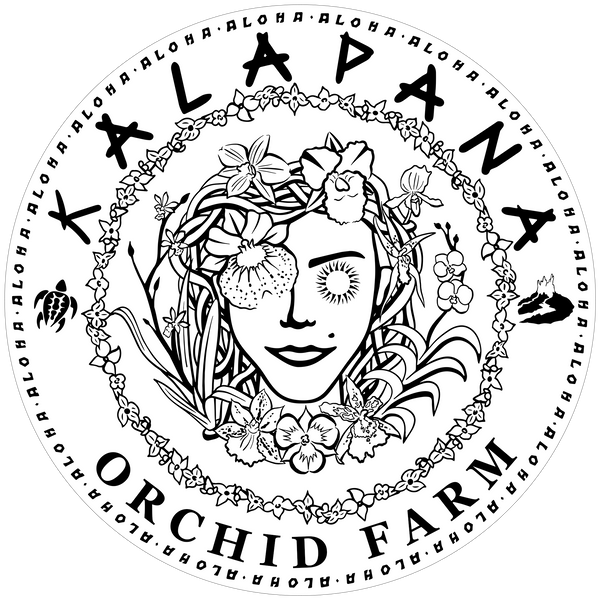Kalapana Orchid Farm
Zglm. Louisendorf 'Rhein Moonlight' x Z. Artur Elle
Zglm. Louisendorf 'Rhein Moonlight' x Z. Artur Elle
Couldn't load pickup availability
We're diving into a fascinating hybrid here, Zygolum Louisendorf 'Rhein Moonlight' crossed with Zygopetalum Artur Elle. This is a grex that's effectively a selfing or backcross with a notable cultivar, resulting in a plant that should strongly express the characteristics of Zygopetalum Artur Elle, but with the potential for enhanced vigor or specific clonal traits from 'Rhein Moonlight'.
To unravel this, let's look at the parentage of each:
Zygolum Louisendorf 'Rhein Moonlight': This is a hybrid registered as (Zygosepalum labiosum x Zygopetalum Artur Elle). The "Zygolum" designation indicates a cross between these two genera.
Zygosepalum labiosum: This species is found as a climbing epiphyte in wet montane forests at elevations below 3,900 ft. across a wide range of northern South America, including French Guiana, Suriname, Guyana, Venezuela, Colombia, Ecuador, Peru, and Brazil. It thrives in hot to warm growing conditions.
Zygopetalum Artur Elle: This well-known hybrid was registered in 1969. Its parents are Zygopetalum Blackii x Zygopetalum B. G. White. Digging a bit deeper, Zygopetalum Blackii is a hybrid of Zygopetalum crinitum x Zygopetalum Perrenoudii. Zygopetalum B. G. White is Zygopetalum Blackii x Zygopetalum mackayi. So, Zygopetalum Artur Elle has a complex lineage with a strong emphasis on Zygopetalum species. Many Zygopetalum species, including Zygopetalum mackayi (a key ancestor), hail from southeastern Brazil, growing as terrestrials or epiphytes in sparse woods or on grassy plains, often at elevations from 4,250 to 5,600 ft., experiencing intermediate to cool temperatures. Zygopetalum crinitum is also from Brazil.
Zygopetalum Artur Elle: As noted above, this is a distinct hybrid with Zygopetalum Blackii x Zygopetalum B. G. White as its parents, tracing back to species like Zygopetalum crinitum and Zygopetalum mackayi, primarily from Brazil.
So, this specific cross, Zygolum Louisendorf 'Rhein Moonlight' x Zygopetalum Artur Elle, is effectively an outcross or backcross that intensifies the genetic contribution of Zygopetalum Artur Elle. You're taking a hybrid that already contains Zygopetalum Artur Elle and crossing it directly with Zygopetalum Artur Elle itself. This suggests an aim to solidify or enhance the desirable traits found in Zygopetalum Artur Elle.
Expect a vigorous, intermediate-growing plant. Pseudobulbs will be ovate to pyriform, 2 to 4 inches tall, often somewhat compressed, topped with 2 to 4 broadly lanceolate, plicate (fan-pleated) leaves that can reach 18 to 24 inches in length and 2 to 3 inches in width. The foliage is typically a rich, vibrant green.
The flowers are the true show. The inflorescence will be an erect to arching spike, emerging from the base of the newest pseudobulb, generally carrying 4 to 8, or even more, highly decorative flowers, each typically 2.5 to 3.5 inches across. The sepals and petals will likely be a striking combination of green and dark markings. Imagine an apple-green or chartreuse background heavily patterned with irregular blotches and stripes of deep chocolate brown, maroon, or even a purplish-black. The lip is the star – broad and often fan-shaped, with a pristine white or cream base color that is intensely veined and splashed with vibrant fuchsia, royal purple, or a rich reddish-brown. Many cultivars of Zygopetalum Artur Elle are known for a stunning blueish cast to the lip under certain lighting. Expect a delightful, strong fragrance, often described as spicy, hyacinth-like, or even peppery, particularly in the mornings. This particular cross, given 'Rhein Moonlight's reputation, may exhibit peloric traits, where the side petals resemble the lip, leading to a fuller, more impressive flower presentation. Blooming usually occurs from winter through spring, and sometimes again in the fall.
Care Instructions:
Light: Provide bright, indirect light. East-facing windows are often ideal. If growing under lights, aim for a moderate intensity. Leaf color should be a healthy, medium green, not yellowish (too much light) or dark green (too little light).
Water: Keep the potting medium consistently moist during active growth, allowing it to approach dryness between waterings, but never allowing it to dry out completely. Reduce watering frequency slightly during cooler, less active periods, but do not let the plant desiccate.
Temperature: Thrives in intermediate temperatures. Daytime temperatures should range from 70 to 80°F. Nighttime temperatures should ideally drop to 55 to 65°F to encourage flowering. Avoid extremes.
Humidity: Maintain moderate to high humidity levels, ideally between 60% and 80%. Good air circulation is essential, especially with higher humidity, to prevent fungal issues like black spot.
Potting Medium: A well-draining, moisture-retentive mix is suitable. A mixture of fine to medium fir bark, perlite, and some sphagnum moss or coco coir works well. Repot every 1 to 2 years, or when the medium starts to break down, typically after flowering.
Fertilizer: During periods of active growth, fertilize every other watering with a balanced orchid fertilizer at half to quarter strength. Reduce or suspend fertilizer applications during the cooler, less active months. Flush the pot with plain water periodically to prevent salt buildup.
Grown in 4" pots.
Share












